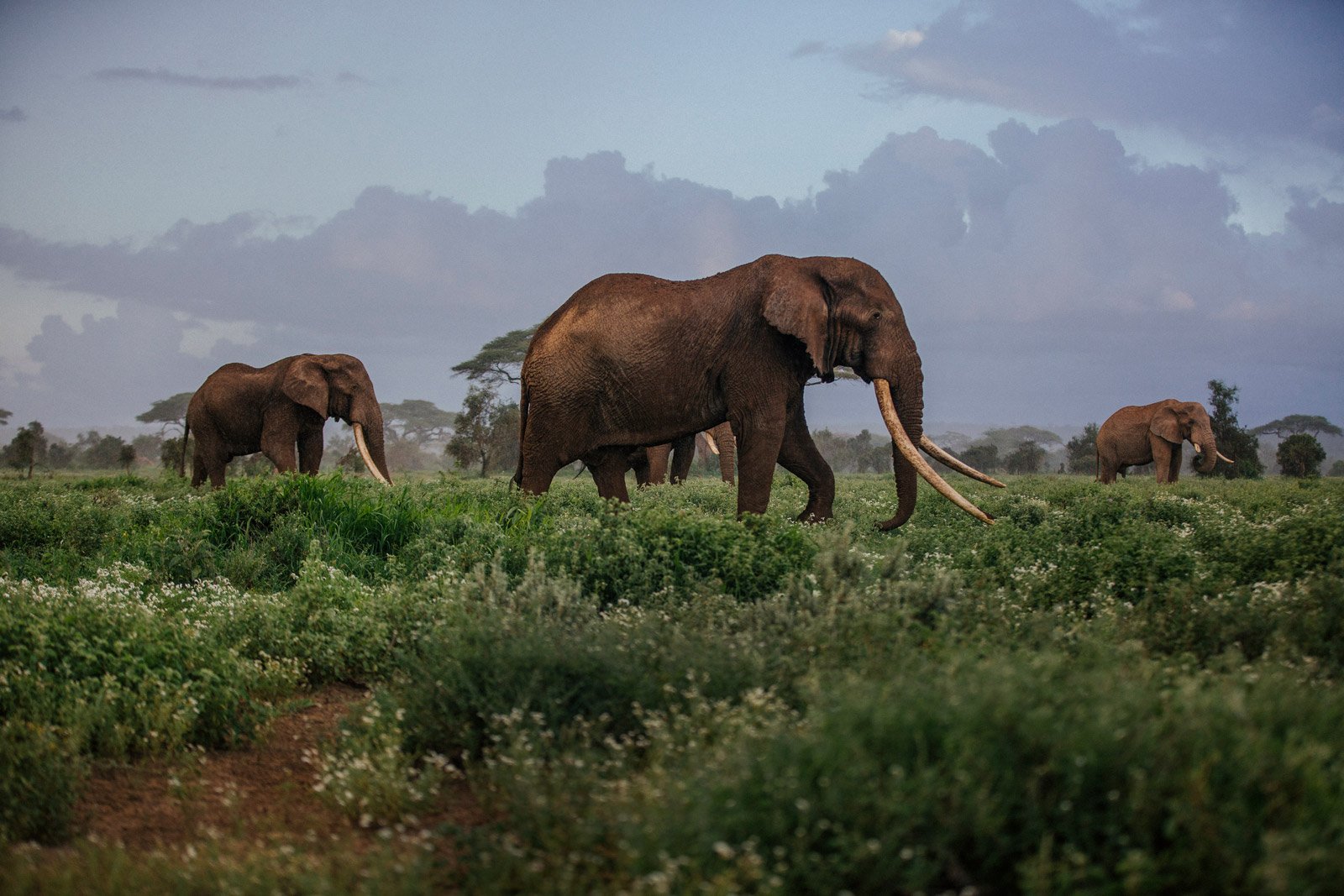
See a Super Tusker Before They are Gone.
Tim (Center) & Tolstoy (left) - Two of Kenya’s most iconic super tusker elephant. Both now deceased.
The last of a dying breed.
There are approximately 20 super tusker elephants remaining in the world. A super tusker is an elephant with ivory that weighs 100 pounds or more per tusk.
The genetic pool for these large-tusked elephants resides mostly in the Tsavo and Amboseli ecosystems in Eastern Kenya. Many of these super tusker genes were the first to go during the poaching crisis in the ‘90s and 2000s.
Several conservation groups, in addition to the Kenya Wildlife Service, are engaged in efforts to give these elephants a fighting chance to pass on these genes, but the genetic pool is aging. Within the past few years, we’ve lost many of the legends including Lugard, Tim, Tolstoy, Dida, and Satao. There are a number of emerging tuskers in the area, but the human and environmental forces that threatened their ancestors may also prevent their survival.
Over the past 30 years, we have witnessed the threat posed on elephants by their own tusks. In some areas such as Gorongosa, elephants have evolved under human pressure to develop smaller tusks or remain tuskless. Will this trend continue with these East African super tuskers?
We take guests on super-tusker-style safaris because we believe that a photographic record of this indicator species has the power to serve as a warning cry for the rest of the planet, and highlight the power humans hold to alter the genes of other species.
The decline in the super tusker is a direct reflection of the years of poaching for the ivory trade and habitat loss. Poaching has dramatically declined, but at its height, much of the super tusker DNA disappeared from the gene pool because large ivory was worth more.
Often, the long-term outcomes are subtle and I feel it is our job as storytellers and guides to highlight those subtle losses and put them into a framework for the public to better understand.
There are still a few super tuskers that are often easy to see in the Chyulu Hills. Others require complex partnerships with conservation organizations using aircraft surveillance to find them. If you are interested in seeing a super tusker, get in touch and we can help build an itinerary which is conservation-facing and helps preserve these creatures in perpetuity.
This story highlight is not like the others. It is a bit more sobering, a bit more journalistic in its imagery. We want to share the incredible experience of being in the midst of a super tusker elephant, but we also want to share the reality these beautiful animals face every day.
*All images above are produced by National Geographic Magazine and by top-level photojournalists such as Brent Stirton & others.

Dida, a female tusker, who died in 2022

Kenya burned a huge stockpile of Ivory in 2016 to send a message to the rest of the world

Tim (Center) & Tolstoy (right) captured from a motorized paraglider

A congregation of over 200 elephants gather in the Shompole Ecosystem in southern Kenya. This landscape comes to life with elephants during the rainy season. Historically, elephants did not frequent this ecosystem, but as other surrounding areas filled up with development, they were pushed into this basin.
In the most recent and ongoing drought, conditions for elephants in the Tsavo and Amboseli ecosystems became dire. Traditional watering holes, known and passed down by matriarchs for generations, were dry. Deaths of wildlife and livestock across all of Eastern Kenya were at an all-time high. It is likely the drought played a significant role in the death of Dida. As climate change looms globally, the results can have direct effects on wildlife.
Land use change and continued development have caused increased pressure on wild landscapes. Available food sources may be scarce during times of drought. Peri-urban sprawl in the Amboseli ecosystem has cut off traditional elephant migratory routes, leaving only one functioning corridor, which is currently under threat.
The night before, Tim, the largest super tusker in the Amboseli ecosystem raided Ben Okoth’s tomato crop, leaving behind a mess and a failed crop. Tim died in 2020 from a twisted gut after raiding a farmer’s tomato crop. His intestines couldn’t handle gas build-up from the overly green vegetation.
At Nairobi’s National Museum, a couple takes a selfie in front of a set of taxidermies. The middle elephant skeleton is “Ahmed” whose tusks were presumed to be some of the largest and heaviest in Africa. He had lived in the forests of Marsabit National Park in Northern Kenya and died in 1974. Since his death, no elephant has recorded tusks of his size.
See A Super Tusker Before They Are Gone.
Location: Eastern Kenya
Camp setup: Multiple options available
How to get there: Via private guided safari
Wildlife: Elephant focused
Activities: Spending time with elephant and hopefully identifying a super tusker
When to Visit: Anytime of year
This experience is highly curated and only occurs with the help of partner conservation organizations and private guides. Please get in touch with us and enquire about how we can make this experience come to life.












